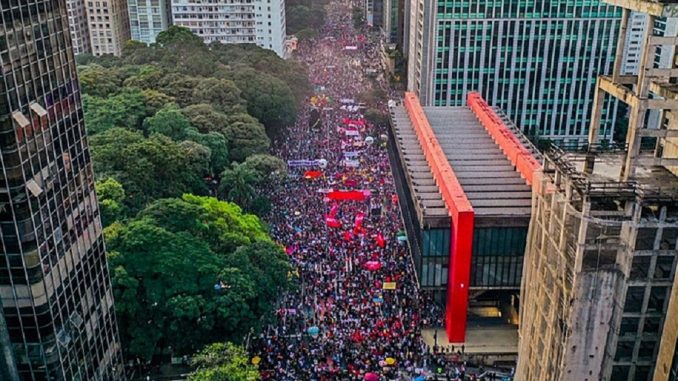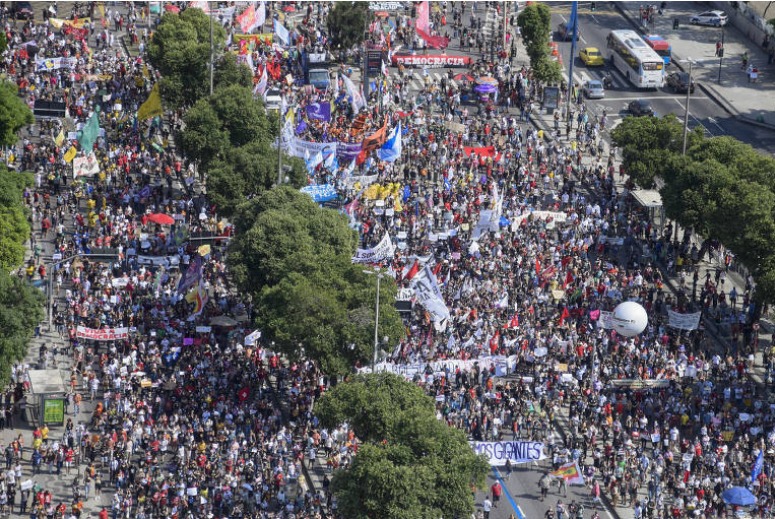
By: Alessandro Fernandes and Verónica O’Kelly – Alternativa Socialista / PSOL – ISL / Brazil.
On May 29 the streets became the stage of massive marches and events. On June 19 a new day of national mobilization is called and it is expected that it will be even greater. The government faces the largest mobilizations against it since the beginning of the pandemic.
Bolsonaro has to convince the right and the capitalists, his allies in 2018, that he continues to be a viable governmental option who can, with a strong and firm hand, carry through the pending austerity agenda. With little margin, because the crisis has made him lose a large part of his social base, weakening him as an option for government. There are many editorials in the bourgeois mass media that pressure him to carry out the privatizations, laws and anti-popular reforms that he promised to guarantee. But the reality is that every time he tries it, he only opens new fronts that he cannot manage, much less stop. It is important to say that it is the traditional parties of the regime that are guaranteeing the unpopular reforms through the presidents of both chambers of Congress, Lira and Pacheco.

The regime creaks and the parties of the traditional right together with the complicit center left try to stop a possible rise in mobilization with fictional scenes such as the current Covid CPI (Parliamentary Investigation Commission), where officials, ministers and entrepreneurs can be heard exposing the atrocities that Bolsonaro and his entourage have been carrying out, cynically mocking the lives of millions. Their objective is to wear him down, but at the same time buy time to reach next year´s elections, because the regime´s main concern is to get out of this situation in the most orderly way possible and with the dirty work finished.
The rotten political, social and economic regime of 88, which was a consequence of the negotiated exit from the dictatorship, is supported by historical and new right-wing sectors, as well as by the left that is assimilated to it, such as the PT or the PCdoB. The current policy of these regime leftists can only stoke anger and ratify their separation from the masses that once followed them, trusting that some solution to their demands could come from them. But, as the reality is much more complex than any blueprint. Despite his separation from the working class and the poor, Lula continues to keep a flame burning in large sectors and is today a strong electoral contender against Bolsonaro for next year´s elections.
Lula has campaigned to replace Bolsonaro in the presidency from the minute he regained his democratic right to run, after the ban imposed by a largely fabricated legal process. In order to honor his prestige as a serious presidential candidate for capital, he makes it very clear that he does not intend to do anything different from what he and the PT did in their 12 years in government. The evidence is in his meetings with right-wing politicians, even with Fernando Henrique Cardoso himself, and his promises to restore the functioning of a “healthy capitalism” for Brazil, where capitalists can do business quietly. The question is: will we get to the elections without a social uprising first? Of course, no one has the answer, but there are policies to encourage or impede that uprising. Lula and the PT have already chosen theirs.
The Social Fronts occupying the place of the Labor Centrals
The process of bureaucratization and adaptation to the state and business institutions of the big labor centrals is not new. Of course, the 12 years of the PT government, together with its total submission to the bourgeois state project, were unforgiving. Today the CUT and other centrals with greater representation in the unionized working class rank-and-file remain almost as spectators of the attacks. Without building mobilization processes in the workplace, they dedicate themselves to participating as organizers of the actions of Social Fronts, diluting the strength that we know our class has when it fights in an organized way.
The CSP-Conlutas, which emerged as a labor process to the left of the CUT and the bureaucracies, has lost strength as a result of its sectarianism, apparatus-heavy and undemocratic methods of its main leadership, the PSTU. Today there is a process of dispute over the leadership, but unfortunately in the face of this new process of rising mobilization, the CSP-Conlutas is far from capable of expressing the sectors that are fighting.
The Social Fronts have great political diversity and are where social and political organizations converge. The Popular Brazil Front, the Fearless Peoples Front, the Bolsonaro Out Campaign and the recently formed People on the Streets are the national fronts that act today, where a dispute is expressed between Lulism and the independent left. The last mobilization on March 29 was called by the new People in the Streets front, which precisely makes this call against the wavering position of the other forces that had been proposing actions but without a strong national commitment. The center left, fundamentally the PT, is the main leadership that tries to pull the hand break on the situation and acts constantly in this regard. The policy against the 29M mobilization was an absolute disgrace, even making official statements in some states calling on people to not mobilize in order to avoid “crowding.”
The youth steps up and opens space for the radical Left
Once again the youth rebelled against those who hesitate and took to the streets. Days before May 29, rallies were held in different states against the budget cuts on public universities. And on May 29, they were clear protagonists and placed their program in the streets. A program that is feminist, for LGBT rights, in favor of the environment and against capitalist depredation, for public health and education, among other demands that were placed expressing a Left program to the liberal capitalist project.
There are debates about the characteristics of this new process of mobilization. Skeptical analysts point to the process opened in 2013 that ended up being capitalized by the Right, which later led to the Bolsonaro presidency in 2018. Of course, this is the point of view of those who not only do not trust the mobilization of our class, but also deny the regressive role that the experience of 12 years of PT government had and the disappointment generated by it in large sections of the masses. Today the Right has its own concrete space for mobilization, the Bolsonarist rallies that never stopped contesting the streets and that for the moment are infinitely smaller numerically speaking. The 29M was called with a main slogan, Fora Bolsonaro, so there is no possibility to interpret that this can be led today by the right.
Radical Left, now more than ever
We cannot deny that there is an open dispute and the Right has not yet been defeated, but that is not due to its strengths but rather to our weaknesses. A radical Left project of class independence, that is a pole of attraction for millions, has not yet appeared on the political scene. The PSOL is undoubtedly an important reference, but the direction that the majority leadership has taken, with important references such as Boulos calling for a repeat of the petista recipe of a class conciliation front and others like Freixo moving away from the PSOL in an even more right-wing course, turn it away from being the tool chosen by the struggling vanguard.
That is why Alternativa Socialista/PSOL, Brazilian section of the ISL, puts all its strength towards building and strengthening the Left of PSOL that defends the independent and socialist program of its foundation, against the project of re-founding and class conciliation. It is for this goal that we signed and promote the Manifesto for the pre-candidacy for president of Glauber Braga. And we want the Radical Left to be at the forefront of this battle for the internal dispute, but keeping an eye on the streets where a new upsurge is beginning to be expressed.
The challenge is for the Latin American giant to come in line with the processes of continental rebellion and for an anti-capitalist and socialist political alternative to emerge from there, overcoming the projects that focus on the elections and end up being sucked into the bourgeois institutions. The bottom moves and cracks the structures that seek to paralyze the upsurge and any independent political emergence. Our task is to bet on the struggle and the construction of that political alternative.








